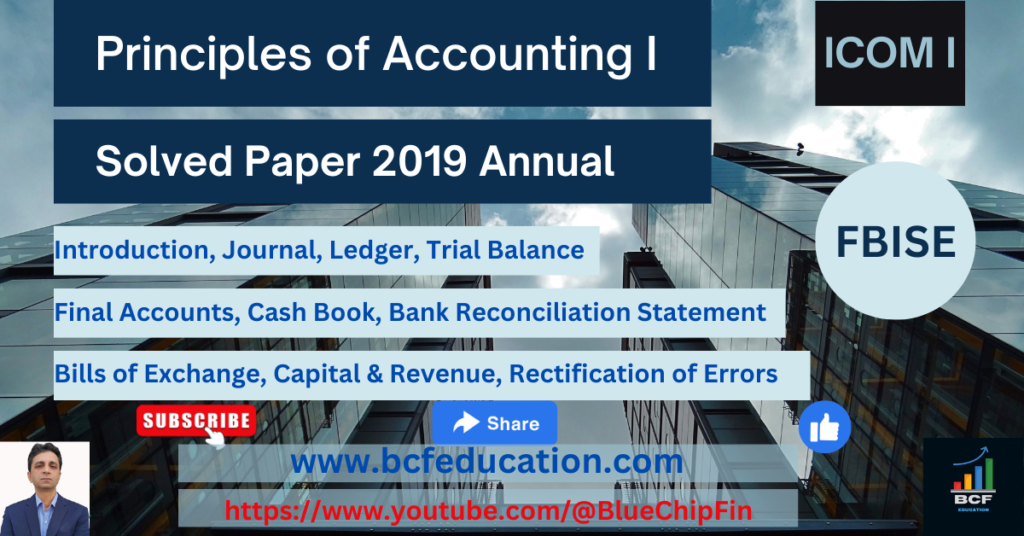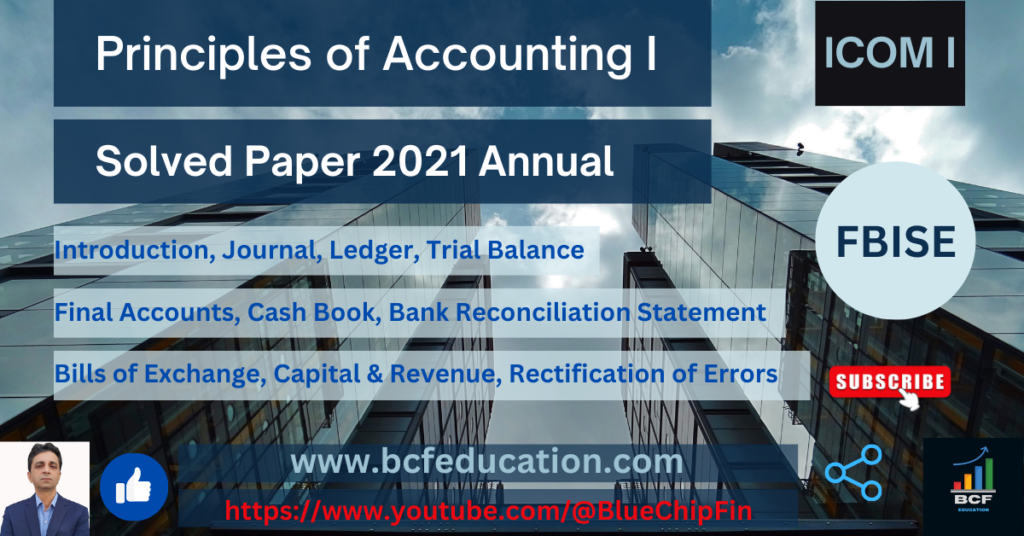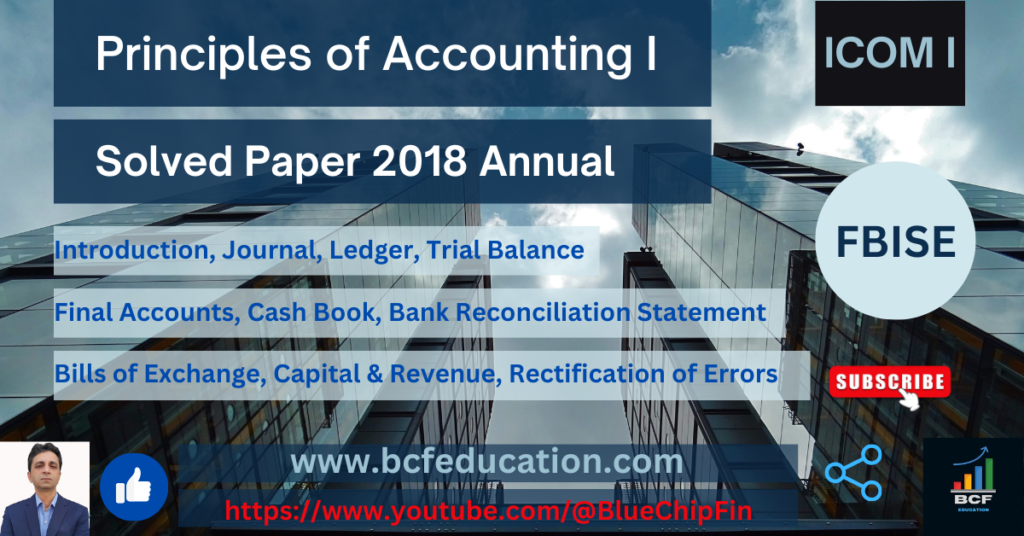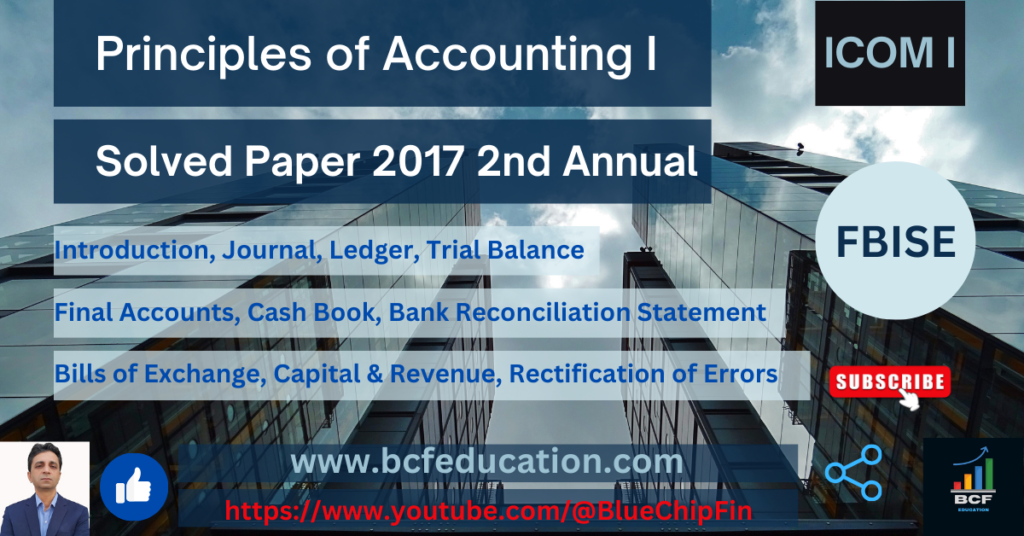In this post, I am going to discuss with you practically about Principles of Accounting, topics Journal, Ledger, Trial Balance with the help of questions asked in paper 2008 of FBISE Federal Board of Intermediate & Secondary Education Islamabad. Each paper will be segmented into three parts. first part will be extracted from the extensive questions, second part related to short questions and third one will be related to MCQ’s
Table of Contents
Principles of Accounting, Paper 2008 ,Journal, Ledger, Trial Balance, Extensive Question & its Solution
Journalize the following transactions, post in the ledger and prepare a trial balance:-
Jan 1 2006 Mr. Nadeem commenced business with Rs.40,000 cash, furniture worth Rs.25,000, motor car valued at Rs.320,000 and stock worth Rs.20,000.
Jan 3 2006 Deposited into Bank Rs.38,000.
Jan .5 2006 Purchased goods on credit from lmran for Rs. 10,000.
Jan 6 2006 Sold goods to Babar on credit for Rs.6,000.
Jan 8 2006 Bought office, supplies from Rafiq & Co. for cash Rs.200.
Jan 10 2006 Goods sold for cash Rs.2,000.
Jan 11 2006 Paid Rs.600 as traveling expenses to salesman.
Jan 12 2006 Withdrew from the bank for personal use Rs. 1,000.
Jan 16 2006 Withdrew from bank for office use Rs.3,000.
Jan 19 2006 Issued a cheque to Imran of Rs. 9200 in full settlement of his account.
Jan 22 2006 Paid carriage in cash Rs.400.
Jan 25 2006 Received a cheque from Babar for Rs.6,000.
Jan 30 2006 Paid rent of the building by cheque Rs.3,000.
Jan 31 2006 Commission received Rs.200.
Jan 31 2006 Bank charges made by bank Rs.250.
Jan 31 2006 Baber’s cheque reported dishonored.
Marks:-
a. Journal
b. Ledger
c. Trial balance
Solution:
(a) Journal
Jan 1 2006 Mr. Nadeem commenced business with Rs.40,000 cash, furniture worth Rs.25,000, motor car valued at Rs.320,000 and stock worth Rs.20,000.
| Date | Particulars | L.F | Dr. | Cr. |
| Jan 1 2006 | Cash A/C | 40,000 | ||
| Furniture A/C | 25,000 | |||
| Motor Car A/C | 320,000 | |||
| Stock A/C | 20,000 | |||
| Capital A/C | 405000 | |||
| (Cash, Furniture Car and stock invested by owner as capital) |
Jan 3 2006 Deposited into Bank Rs.38,000.
| Jan 3 2006 | Bank A/C | 38,000 | ||
| Cash A/C | 38,000 | |||
| (Cash deposited into bank) |
Jan .5 2006 Purchased goods on credit from lmran for Rs. 10,000.
| Jan 5 2006 | Purchases A/C | 10,000 | ||
| Imran’s A/C | 10,000 | |||
| (Goods bought on credit) |
Jan 6 2006 Sold goods to Babar on credit for Rs.6,000.
| Jan 6 2006 | Babar’s A/C | 6000 | ||
| Sales A/C | 6000 | |||
| (Goods sold on credit) |
Jan 8 2006 Bought office, supplies from Rafiq & Co. for cash Rs.200.
| Jan 8 2006 | Office Supplies A/C | 200 | ||
| Cash A/C | 200 | |||
| (Bought Office Supplies on Cash) |
Jan 10 2006 Goods sold for cash Rs.2,000.
| 10th Jan, 2006 | Cash A/C | 2000 | ||
| Sales A/C | 2000 | |||
| (Goods sold on cash) |
Jan 11 2006 Paid Rs.600 as traveling expenses to salesman.
| 11th Jan, 2006 | Travelling Expenses A/C | 600 | ||
| Cash A/C | 600 | |||
| (Travelling expenses paid) |
Jan 12 2006 Withdrew from the bank for personal use Rs. 1,000.
| 12th Jan, 2006 | Drawing A/C | 1000 | ||
| Bank A/C | 1000 | |||
| (Withdrew from bank for personal use) |
Jan 16 2006 Withdrew from bank for office use Rs.3,000.
| 16th Jan, 2006 | Cash A/C | 3000 | ||
| Bank A/C | 3000 | |||
| (Withdrew from bank for personal use) |
Jan 19 2006 Issued a cheque to Imran of Rs. 9200 in full settlement of his account.
| 19th Jan, 2006 | Imran A/C | 10,000 | ||
| Bank A/C | 9200 | |||
| Discount A/C | 800 | |||
| (Amount paid to Imran and discount received) |
Jan 22 2006 Paid carriage in cash Rs.400.
| 22nd Jan, 2006 | Carriage A/C | 400 | ||
| Cash A/C | 400 | |||
| (Carriage paid) |
Jan 25 2006 Received a cheque from Babar for Rs.6,000.
| 25th Jan, 2006 | Bank A/C | 6000 | ||
| Babar’s A/C | 6000 | |||
| (Amount received from Babar through cheque) |
Jan 30 2006 Paid rent of the building by cheque Rs.3,000.
| 30th Jan, 2006 | Rent A/C | 3000 | ||
| Bank A/C | 3000 | |||
| (Rent of building paid through cheque) |
Jan 31 2006 Commission received Rs.200.
| 31st Jan, 2006 | Cash A/C | 200 | ||
| Commission A/C | 200 | |||
| (Commission Received) |
Jan 31 2006 Bank charges made by bank Rs.250.
| 31st Jan, 2006 | Bank Charges A/C | 250 | ||
| Bank A/C | 250 | |||
| (Bank charges paid) |
Jan 31 2006 Baber’s cheque reported dishonored.
| 31st Jan, 2006 | Babar’s A/C | 6000 | ||
| Bank A/C | 6000 | |||
| (Babar’s Cheque returned dishonored) |
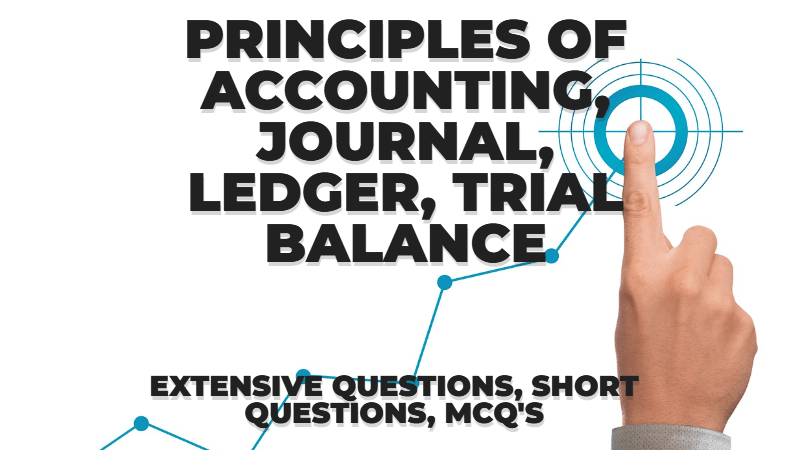
(b) Ledger
Cash A/C
| Date | Particulars | Amount | Date | Particulars | Amount |
| 1st Jan, 2006 | Capital A/C | 40,000 | 3rd Jan, 2006 | Bank A/C | 38,000 |
| 10th Jan, 2006 | Sales A/C | 2000 | 8th Jan, 2006 | Office Supplies A/C | 200 |
| 16th Jan, 2006 | Bank A/C | 3000 | 11th Jan, 2006 | Travelling Expense A/C | 600 |
| 31st Jan, 2006 | Commission A/C | 200 | 22nd Jan, 2006 | Carriage A/C | 400 |
| 31st Jan, 2006 | Balance c/d | 6000 | |||
| 45,200 | 45,200 |
Bank A/C
| Date | Particulars | Amount | Date | Particulars | Amount |
| 3rd Jan, 2006 | Cash A/C | 38,000 | 12th Jan, 2006 | Drawing A/C | 1000 |
| 25th Jan, 2006 | Babar’s A/C | 6000 | 16th Jan, 2006 | Cash A/C | 3000 |
| 19th Jan, 2006 | Imran A/C | 9200 | |||
| 30th Jan, 2006 | Rent A/C | 3000 | |||
| 31st Jan, 2006 | Bank Charges A/C | 250 | |||
| 31st Jan, 2006 | Babar’s A/C | 6000 | |||
| 31st Jan, 2006 | Balance c/d | 21550 | |||
| 44,000 | 44,000 |
Furniture A/C
| Date | Particulars | Amount | Date | Particulars | Amount |
| 1st Jan, 2006 | Capital A/C | 25,000 | |||
| 31st Jan, 2006 | Balance c/d | 25,000 | |||
| 25,000 | 25,000 |
Motor Car A/C
| Date | Particulars | Amount | Date | Particulars | Amount |
| 1st Jan, 2006 | Capital A/C | 320,000 | |||
| 31st Jan, 2006 | Balance c/d | 320,000 | |||
| 320,000 | 320,000 |
Stock A/C
| Date | Particulars | Amount | Date | Particulars | Amount |
| 1st Jan, 2006 | Capital A/C | 20,000 | |||
| 31st Jan, 2006 | Balance c/d | 20,000 | |||
| 20,000 | 20,000 |
Capital A/C
| Date | Particulars | Amount | Date | Particulars | Amount |
| 1st Jan, 2006 | Cash A/C | 40,000 | |||
| 1st Jan, 2006 | Furniture A/C | 25,000 | |||
| 1st Jan, 2006 | Motor Car A/C | 320,000 | |||
| 1st Jan, 2006 | Stock A/C | 20,000 | |||
| 31st Jan, 2006 | Balance c/d | 40,5000 | |||
| 40,5000 | 40,5000 |
Purchases A/C
| Date | Particulars | Amount | Date | Particulars | Amount |
| 5th Jan, 2006 | Imran A/C | 10,000 | |||
| 31st Jan, 2006 | Balance c/d | 10,000 | |||
| 10,000 | 10,000 |
Imran’s A/C
| Date | Particulars | Amount | Date | Particulars | Amount |
| 19th Jan, 2006 | Bank A/C | 9200 | 5th Jan, 2006 | Purchases A/C | 10,000 |
| 19th Jan, 2006 | Discount A/C | 800 | |||
| 10,000 | 10,000 |
Babar’s A/C
| Date | Particulars | Amount | Date | Particulars | Amount |
| 6th Jan, 2006 | Sales A/C | 6000 | 25th Jan, 2006 | Bank A/C | 6000 |
| 31st Jan, 2006 | Bank A/C | 6000 | |||
| 31st Jan, 2006 | Balance c/d | 6000 | |||
| 12,000 | 12,000 |
Sales’s A/C
| Date | Particulars | Amount | Date | Particulars | Amount |
| 6th Jan, 2006 | Babar’s A/C | 6000 | |||
| 10th Jan, 2006 | Cash A/C | 2000 | |||
| 31st Jan, 2006 | Balance c/d | 8000 | |||
| 8000 | 8000 |
Office Supplies A/C
| Date | Particulars | Amount | Date | Particulars | Amount |
| 8th Jan, 2006 | Cash A/C | 200 | |||
| 31st Jan, 2006 | Balance c/d | 200 | |||
| 200 | 200 |
Travelling Expense A/C
| Date | Particulars | Amount | Date | Particulars | Amount |
| 11th Jan, 2006 | Cash A/C | 600 | |||
| 31st Jan, 2006 | Balance c/d | 600 | |||
| 600 | 600 |
Drawing A/C
| Date | Particulars | Amount | Date | Particulars | Amount |
| 12th Jan, 2006 | Bank A/C | 1000 | |||
| 31st Jan, 2006 | Balance c/d | 1000 | |||
| 1000 | 1000 |
Discount A/C
| Date | Particulars | Amount | Date | Particulars | Amount |
| 19th Jan, 2006 | Imran A/C | 800 | |||
| 31st Jan, 2006 | Balance c/d | 800 | |||
| 800 | 800 |
Carriage A/C
| Date | Particulars | Amount | Date | Particulars | Amount |
| 22nd Jan, 2006 | Cash A/C | 400 | |||
| 31st Jan, 2006 | Balance c/d | 400 | |||
| 400 | 400 |
Rent A/C
| Date | Particulars | Amount | Date | Particulars | Amount |
| 30th Jan, 2006 | Cash A/C | 3000 | |||
| 31st Jan, 2006 | Balance c/d | 3000 | |||
| 3000 | 3000 |
Bank Charges A/C
| Date | Particulars | Amount | Date | Particulars | Amount |
| 31st Jan, 2006 | Bank A/C | 250 | |||
| 31st Jan, 2006 | Balance c/d | 250 | |||
| 250 | 250 |
Commission A/C
| Date | Particulars | Amount | Date | Particulars | Amount |
| 31st Jan, 2006 | Cash A/C | 200 | |||
| 31st Jan, 2006 | Balance c/d | 200 | |||
| 200 | 200 |
(c) Trial Balance
| Account Title | Dr. | Cr. |
| Cash A/C | 6000 | |
| Bank A/C | 21550 | |
| Furniture A/C | 25,000 | |
| Motor Car A/C | 320,000 | |
| Stock A/C | 20,000 | |
| Capital A/C | 40,5000 | |
| Purchases A/C | 10,000 | |
| Babar’s A/C | 6000 | |
| Sales A/C | 8000 | |
| Office Supplies A/C | 200 | |
| Travelling Expense A/C | 600 | |
| Drawing A/C | 1000 | |
| Discount A/C | 800 | |
| Carriage A/C | 400 | |
| Rent A/C | 3000 | |
| Bank Charges A/C | 250 | |
| Commission A/C | 200 | |
| Total | 414,000 | 414,000 |
Principles of Accounting, Paper 2008 ,Journal, Ledger, Trial Balance, Short Questions
(i) Define double entry system of book keeping.
Answer:It is an Accounting method of recording transactions in which at-least two accounts are used in Debit and Credit aspects. In double entry book-keeping, debit side must be equals to credit side.
(ii) Define and explain three classes of account.
Answer:Under Classical approach there are three types of accounts as given below:
- Personal Accounts: are accounts of real persons and organizations such as Ali’s Account, Google’s Account etc.
- Real Accounts: are accounts related to assets both tangible and intangibles such as property, land, building, goodwill, patents etc.
- Nominal Accounts: are accounts related to Income, Profits, Expenses and losses such as rent, commission, interest, sales, wages, gain or loss etc.
(iii) Define the term ‘owner’s equity’.
Answer:Owner’s Equity is share of ownership of shareholder in the company after paying all the liabilities of the company at the time of liquidation of the company.
(iv) State different types of transactions for drawings.
Answer:Drawing is simply withdrawal of owner’s asset out of business for his/her personal use. It is contra to owner’s equity or capital. Types of transactions are given below:
Cash Drawing
Drawing A/C (Dr.)
Cash/Bank A/C (Cr.)
Drawing of goods
Drawing A/C (Dr.)
Purchases/Stock A/C (Cr.)
Drawing of assets other than goods
Drawing A/C (Dr.)
other Asset A/C (Cr.)
(v) State two types of trial balance.
Answer: There are two types of trial balance.
- Unadjusted Trial Balance: It is made before recording adjusting entries. It is simply verification of accounts either debit side is equal to credit side or not.
- Adjusted Trial Balance: It is made after making unadjusted trial balance. All the adjusting entries are taken into account and included in unadjusted trial balance and result is called adjusted trial balance.
Principles of Accounting, Paper 2008 ,Journal, Ledger, Trial Balance, MCQ’s
(i) What is the art of recording, classifying and summarizing business transactions called?
A. Journalizing B. Book keeping
C. Accounting D. All of these
(ii) What is the modern system of book keeping called?
A. Most modern B. Single entry
C. Double entry D. None of these system
(iii) What account are the items or goods purchased by the business for the sole use of its proprietor debited to?
A. Merchandize B. Goods
C. Purchases D. Drawings
(iv) What is the business called that purchases goods and sells them without changing their shape?
A. Manufacturing concern B. Trading concern
C. Services business D. None of these
(v) Which of the following is the true form of accounting equation?
A. Liabilities = assets – capital B. Assets = liabilities – capital
C. Capital = assets – liabilities D. Assets = liabilities + capital
(vi) What is trial balance known as?
A. Classification of transactions. B. Recording of transactions.
C. Summary of transactions D. None of these.
(vii) What account do expenses and losses fall under?
A. Personal accounts B. Nominal accounts
C. Real accounts. D. All of these
(viii) Which one of the following results in decrease in assets and liabilities?
A. Purchase of goods on credit. B. Sale of assets on credit.
C. Payment to creditors. D. Receipt of bank loan.
(ix) Which of the following is correct according to the rules?
A. Increase in assets and decrease in liabilities is debited.
B. Increase in purchases and decreases in sales is debited.
C. Increase in expenses and decrease income.
D. All of these.
You may also interested Cambridge IGCSE/O-Level Accounting:


